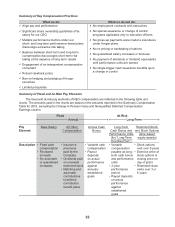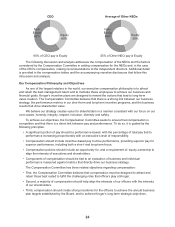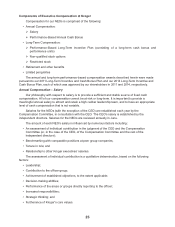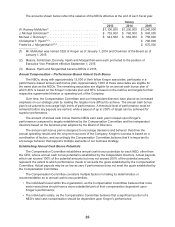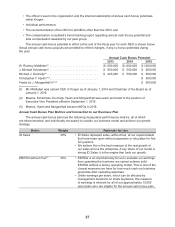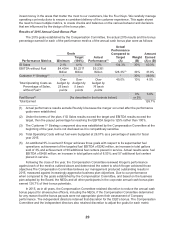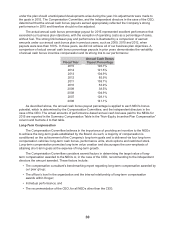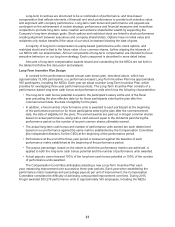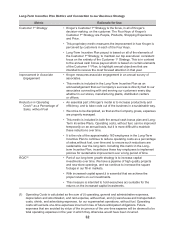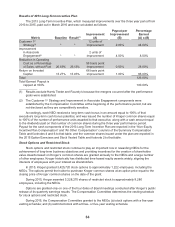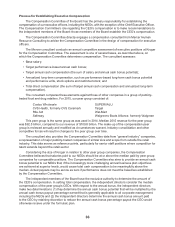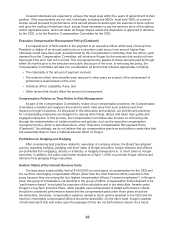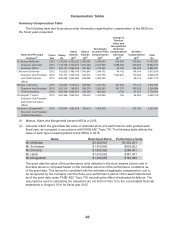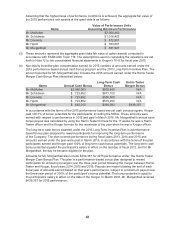Kroger 2015 Annual Report Download - page 34
Download and view the complete annual report
Please find page 34 of the 2015 Kroger annual report below. You can navigate through the pages in the report by either clicking on the pages listed below, or by using the keyword search tool below to find specific information within the annual report.
32
Long-Term Incentive Plan Metrics and Connection to our Business Strategy
Metric Rationale for Use
Customer 1st Strategy • Kroger’s Customer 1st Strategy is the focus, in all of Kroger’s
decision-making, on the customer. The Four Keys of Kroger’s
Customer 1st Strategy are People, Products, Shopping Experience
and Price.
• This proprietary metric measures the improvement in how Kroger is
perceived by customers in each of the Four Keys.
• Long-Term Incentive Plan payout is based on all of the elements of
the Customer 1st Strategy, to maintain our top executives’ consistent
focus on the entirety of the Customer 1st Strategy. This is in contrast
to the annual cash bonus payout which is based on certain elements
of the Customer 1st Plan, to highlight annual objectives that are
intended to receive the most focused attention in that year.
Improvement in Associate
Engagement
• Kroger measures associate engagement in an annual survey of
associates.
• This metric is included in the Long-Term Incentive Plan as an
acknowledgement that our Company’s success is directly tied to our
associates connecting with and serving our customers every day,
whether in our stores, manufacturing plants, distribution centers
or offices.
Reduction in Operating
Costs(1) as a Percentage of
Sales, without Fuel
• An essential part of Kroger’s model is to increase productivity and
efficiency, and to take costs out of the business in a sustainable way.
• We strive to be disciplined, so that as the Company grows, expenses
are properly managed.
• This metric is included in both the annual cash bonus plan and Long-
Term Incentive Plans. Operating costs, without fuel, can be improved
temporarily on an annual basis, but it is more difficult to maintain
these reductions over time.
• It is the role of the approximately 160 employees in the Long-Term
Incentive Plan to continue to reduce operating costs as a percentage
of sales,without fuel, over time and to ensure such reductions are
sustainable over the long-term. Including this metric in the Long-
term Incentive Plan, incentivizes these key employees to implement
policies for sustainable improvement over a long period of time.
ROIC(2) • Part of our long-term growth strategy is to increase capital
investments over time. We have a pipeline of high quality projects
and new store openings, and we continue to increase the square
footage in our fill-in markets.
• With increased capital spend,it is essential that we achieve the
proper returns on our investments.
• This measure is intended to hold executives accountable for the
returns on the increased capital investments.
(1) Operating Costs is calculated as the sum of (i) operating, general and administrative expenses,
depreciation and amortization, and rent expense, without fuel, and (ii) warehouse and transportation
costs, shrink, and advertising expenses, for our supermarket operations, without fuel. Operating
costs will exclude one-time expenses incurred in lieu of future anticipated obligations. Future
expenses that are avoided by virtue of the incurrence of the one-time expense will be deemed to be
total operating expenses in the year in which they otherwise would have been incurred.


